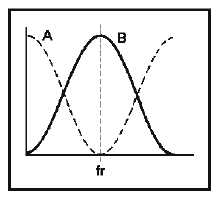5
1-27. In the parallel-resonant circuit, which of
the following circuit conditions is NOT
normal?
1. XC equals XL
2. IC equals IL
3. Iline is minimum
4. Iline is maximum
Figure 1D.—Parallel-resonant circuit curves.
IN ANSWERING QUESTIONS 1-28 AND
1-29, REFER TO FIGURE 1D.
1-28. In the figure, what does response curve A
represent?
1. Current
2. Impedance
3. Reactance
4. Resistance
1-29. What does response curve B represent?
1. Power
2. Impedance
3. Reactance
4. Resistance
1-30. As a parallel-resonant circuit approaches
resonance, which of the following circuit
actions takes place?
1. Impedance decreases
2. Oscillating current increases
3. Inductance increases
4. Capacitance decreases
1-31. When a parallel-resonant circuit operates
BELOW resonance, which of the
following component characteristics
describes circuit action?
1. Inductive
2. Capacitive
3. Resistive
1-32. When a parallel-resonant circuit operates
ABOVE resonance, which of the
following component characteristics
describes circuit actions?
1. Inductive
2. Capacitive
3. Resistive
1-33. In a parallel-resonant circuit, which of
the following circuit conditions is
observed?
1. Oscillating current is less than line
current
2. Oscillating current is greater than line
current
3. Line current is maximum
4. Impedance is minimum
1-34. What is the level of impedance offered at
resonance in (a) a series-resonant circuit
and (b) a parallel-resonant circuit?
1. (a) High
(b) high
2. (a) High
(b) low
3. (a) Low
(b) low
4. (a) Low
(b) high
1-35. The ability of a resonant circuit to
separate currents of desired frequencies
from those of undesired frequencies
makes them useful in which of the
following circuit applications?
1. Filters
2. Counters
3. Amplifiers
4. Voltage dividers


